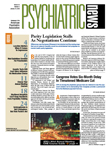Foster children covered by Medicaid are frequently prescribed three or more psychotropic drugs simultaneously, often off-label and sometimes not specifically relevant to the child's diagnosis, according to a random sample of Medicaid-insured Texas youth.
Psychotropic drug treatment is also three or four times more common among those in foster care compared with peers who are not in foster care but are eligible for Medicaid because of low family income.
The study by Julie Zito, Ph.D., an associate professor of pharmacy and psychiatry at the University of Maryland, and colleagues appears in the January Pediatrics.
Evidence for the risks, benefits, or outcomes of using three, four, or five drugs concomitantly are unclear, but appear to be increasing nevertheless, wrote Zito.
There were 32,135 people aged 19 or younger in Texas foster care and on Medicaid during the study year, from September 2003 to August 2004. The researchers looked at a sample of 472 children and adolescents in one typical month (July 2004) to gauge practices among the 12,189 youth medicated with psychotropic drugs. Diagnoses among these youth included ADHD (39 percent), depression (36 percent), adjustment/anxiety disorders (34 percent), oppositional defiant or conduct disorder (21 percent), and bipolar disorder (17 percent).
“The concomitant use of three or more psychotropic medication classes... varied little by diagnosis, suggesting the use of multiple classes, may reflect a symptom-specific rather than a categorical approach,” said the authors. This emphasis on symptoms, rather than on severity or functional status, may have led to more diagnoses of comorbid conditions and contributed to the use of multiple drugs, they said.
More diagnoses and greater medication use among foster children should come as no surprise, said William Narrow, M.D., Ph.D., associate director for diagnosis and classification in the APA Division of Research. “Family disruption, being an abuse victim, and lack of support can lead to increased risk for behavioral problems among foster-care children, and therefore to increased medication use.”
Of the 472 youth studied, 130 received just one drug, while the remaining 72 percent had been prescribed two or more, and 41 percent received three or more drugs. Sometimes physicians prescribed more than one drug in the same class.
The researchers found some discordant patterns in prescribing, especially given that few drugs are approved by the Food and Drug Administration (FDA) for use in young people.
Psychotropic use in general was also much higher than in some comparable studies, as was antipsychotic use. However, stimulant use among youth diagnosed with ADHD was lower.
Nevertheless, antipsychotic drugs were prescribed at nearly similar rates (76 percent to 84 percent) across the three major diagnostic groups: ADHD, depression, and adjustment/anxiety disorders. All the antipsychotics used lacked FDA approval for youth at the time, and all anticonvulsant drugs were off-label for psychiatric indications in that age group.
In contrast, the antidepressant fluoxetine—which is approved for depression treatment in young people—was used lightly, while sertraline and escitalopram, without indications for most uses in this population, accounted for 74 percent of SSRIs prescribed.
Finally, any possible treatment advantage to dispensing three or more drugs from different psychotropic medication classes is not clear, said the researchers. “Consequently, benefit/risk research assessments seem to be important for informing practitioners about the best treatment practices.”
In 2007 Texas rewrote its practice guidelines for youth in foster care to require a department review if antipsychotic agents and antidepressants were prescribed for youth under age 4 or stimulants for those under age 3, if two or more drugs from the same class were prescribed concomitantly, or if at least five different classes of drugs were prescribed at the same time.
